Good morning, it's my great pleasure to join you for breakfast today.
Can I particularly thank Don Matthews [AI Group National President]; Chris Ogilvy [President of the AI Group Victorian Branch]; Heather Ridout [Chief Executive, AI Group] and the Victorian Councillors for the opportunity to meet with you here in Melbourne.
I last addressed the AI Group just over one year ago, a few days after the Government had announced its Economic Security Strategy. I spoke then about the need for decisive and coordinated policy action and my desire to work closely with the business community in grappling with the monumental challenges that lay ahead.
As you know, what followed were another two phases of economic stimulus, and a white-knuckle ride for the global economy that has left the other advanced economies faring much worse than our own. This was borne out in the updated economic and fiscal outlook I released on Monday.
One of the things people focused on was the improved unemployment number – now forecast to peak at 6¾ per cent in the middle of 2010, well down on the Budget forecast rate of 8½ per cent.
I want to give you credit for a large part of that revision. The fall in hours worked that we have already experienced is equivalent to a loss of more than 200,000 full-time jobs. This means that we have effectively dodged another 1½ percentage point rise in the unemployment rate. All this is because employers and employees have agreed to cushion the impact of the downturn by reducing hours instead of laying-off staff.
This is a great example of Australian business and employees pitching in to meet a national challenge. You have kept a dire economic situation from being far worse.
In the most challenging economic environment in 75 years, you saw value in your employees and you moved heaven and earth to keep them. You measured their contribution in the years past and their likely contribution to the years ahead.
It took courage and it took loyalty – and I want you to understand that I recognise that.
Of course, stimulus also played an important part in protecting the nation's skills base and capital base. And this is what I'd like to focus on today – government investment delivering lasting gains for business and the community, putting us in a strong position for the recovery.
The Revised Economic Outlook
First let me run you through the revised forecasts for our economy, which is weathering the global recession much better than we expected at Budget, despite the considerable challenges that remain.
The MYEFO forecasts are for stronger growth of 1½ per cent in 2009-10 and 2¾ per cent in 2010-11. These are significant upgrades from the Budget forecasts of a contraction of ½ of a per cent in 2009-10 and growth of 2¼ per cent in 2010-11.
These forecasts underscore Australia's position as the strongest performing advanced economy in the world — a substantial achievement that all Australians can be proud of.
Chart One: Strongest performing advanced economy
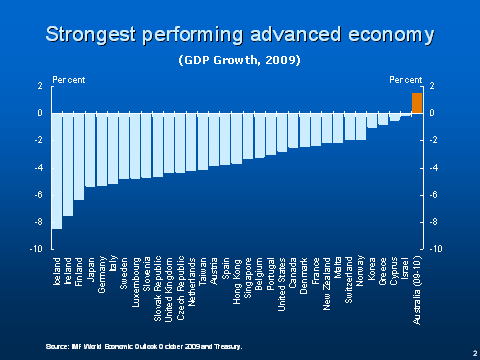
Our fiscal position is also improved, though the global recession has still stripped something like $170 billion out of the Budget.
As revenues recover, the Government's fiscal strategy will deliver lower deficits and debt across the forward estimates. Net debt is now expected to peak at 10 per cent of GDP, around $50 billion lower than expected at Budget.
Chart Two: Net debt peaks lower
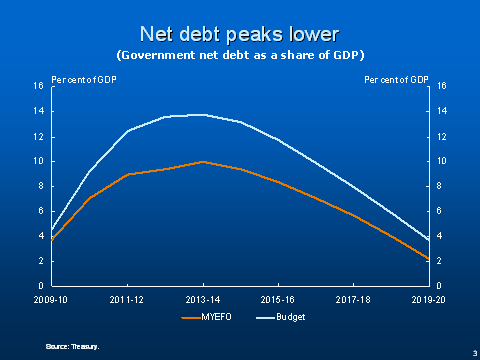
And I mentioned before the improved outlook for peak unemployment – down from 8½ per cent to 6¾ per cent.
But I want to be careful to balance this good news with some other facts.
Despite the improved outlook, the economy is expected to continue to operate below capacity for some time.
It is also worth looking at some of the more detailed forecasts for the current year:
- Forecast employment growth of ¼ of a per cent to June 2010, while vastly improved from Budget, is clearly not sufficient to absorb the natural growth in the labour force. The implication is that unemployment should continue to rise – sobering news for the additional 105,000 people we expect to be affected.
- At 1¼ per cent, nominal GDP is expected to post its weakest annual growth in almost 50 years.
- Driven by a large decline in the terms of trade, Australia's annual export income is expected to plummet by over $55 billion or 19½ per cent.
- Company profits are expected to shrink by around 3¼ per cent.
- Private final demand is forecast to contract by ¾ of a per cent, for the first time since the 1990s recession.
- And business investment is predicted to record a 6½ per cent fall, its sharpest fall since the early 1990s.
It's for all of these reasons that the Government has judged that the planned gradual withdrawal of fiscal stimulus remains appropriate.
As you know, our stimulus is already designed to gradually scale back as a private sector recovery takes hold throughout 2010. Its peak impact on growth occurred in the June quarter 2009, and its impact on growth is already moderating.
Our stimulus will actually begin to subtract from growth from the March quarter 2010 because of the very fact that it is temporary. For example, we have already seen the First Home Owners Boost phase down at the end of September, and it will automatically cease at the end of the year.
Chart Three: Withdrawal of fiscal stimulus
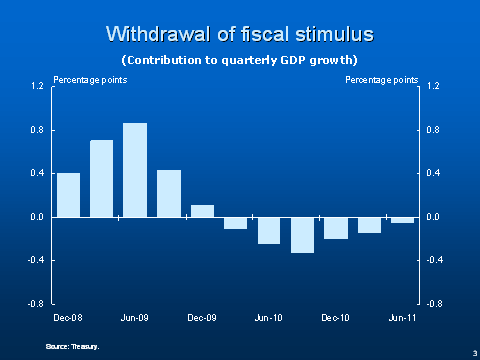
As you can see from this chart, public demand is a key driver of GDP growth in 2009-10, when private demand will be weakest. In fact, on Treasury estimates, our stimulus accounts for all of the growth in 2008-09 and 2009-10.
But as private sector demand returns in 2010-11, the public sector pulls back. You see that starkly in the two sets of bars in the chart.
Chart Four: Public sector contribution to growth
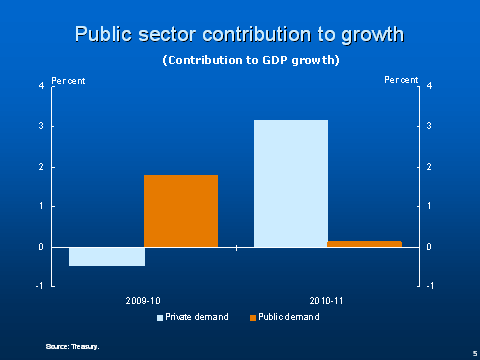
The second reason we have judged our stimulus plans remain appropriate is that the vast bulk of the stimulus that remains is in critical nation building infrastructure. Investments in our major highways, rail upgrades, ports, hospitals and schools.
Investments like the Regional Rail Express project here in Victoria. The Commonwealth is contributing $3.2 billion to this major investment, worth $4.3 billion in total, which when completed will deliver capacity for an extra 9,000 regional and suburban passengers every hour.
Our program of infrastructure investment is not only supporting a pipeline of work for businesses today, it is also building productive capacity for the future. And that's critical to providing a stronger platform for sustainable growth with low inflation into the future.
It's temporary spending, with lasting gains.
And it will leave a legacy of improved social and economic infrastructure that provides better social services and supports the productivity of Australian businesses in the future.
The Government's infrastructure spending will also help to maintain Australia's capital stock through this downturn, despite the expected falls in private investment.
Treasury has estimated that nominal private business investment is set to be around $42 billion lower through the downturn as a consequence of the global recession.
As this chart demonstrates, the Government's investment will offset the weakness in private investment, helping to maintaining total investment in the Australian economy as a share of the total economy. Here, again, we see Government investment supporting the economy when it is needed, and then being withdrawn as the economy recovers.
Chart Five: Infrastructure stimulus supporting investment
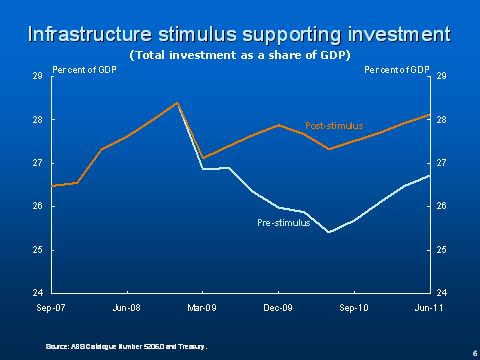
Avoiding Permanent Destruction
By avoiding capital destruction, our infrastructure stimulus also delivers long-lasting benefits.
Now, all of you in this room know that avoiding a sharp recession is not just an end in itself, it means avoiding the destruction of valuable skills and capital in the economy. Existing capital can be stranded or run down. And there is a failure to invest in new capital.
Downturns can have long-lasting effects on the economy going forward, on business like yours and on the community more broadly. And the deeper the downturn, the worse this would be.
The Government's economic stimulus program has helped limit the destruction that would otherwise have been caused by the global recession. .
This has lead to a permanent increase in the size of the economy – Australia's income – all because we invested in our future through economic stimulus.
Government investment in the economy has had a significant impact in offsetting weakness in the private sector. And it is building the capacity that will sustain future growth.
The Small Business and General Business Tax Break has provided vital stimulus to support jobs and help small businesses doing it tough. It has allowed many businesses to bring forward and not postpone or abandon business investment in the face of the global recession.
The tax breaks clearly led to stronger sales of motor vehicles and other business-related machinery and equipment in the June quarter. Treasury estimates that new business investment would have contracted in the June quarter without the tax break.
This additional investment supported the economy during the downturn. But it also means that SMEs across the country have taken the opportunity to upgrade their equipment, ready to make the most of the economic recovery.
Abandoning the stimulus now would drive more businesses to the wall, it would leave many tens of thousands more Australians without jobs, and it would permanently damage our economy.
Confidence
So far I have talked about levels of private and public demand, investment and GDP growth. I would now like to turn to something a little less tangible – confidence.
Not only has stimulus supported activity. It has underwritten confidence in the Australian economy. It has given consumers the confidence to keep spending. It has given businesses the confidence to keep trading; to retain staff. It has given businesses good reason to remain optimistic about the future.
I've said on several occasions now that the impact of the stimulus is far greater than the sum of its parts. And confidence is a key aspect of this.
The Westpac-Melbourne Institute index of consumer sentiment has rebounded by nearly 50 per cent from the period just before the fiscal stimulus. This improvement exceeds the average OECD outcome by a considerable margin.
Chart Six: Confidence
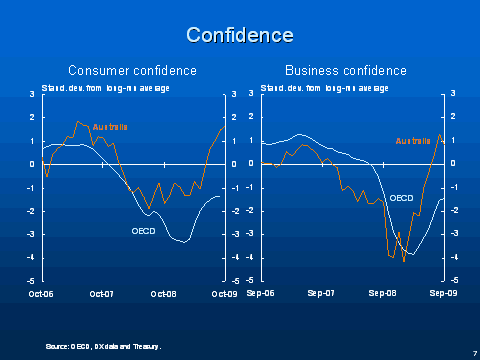
Business confidence has similarly staged a solid recovery, albeit with a slight reversal in the latest month of the NAB survey. Business confidence is currently around six-year highs. Again the turnaround looks like it has exceeded that experienced elsewhere.
Our direct payments to households and the savings from lower mortgage rates have helped keep the cash registers ticking over.
Chart Seven: Retail sales
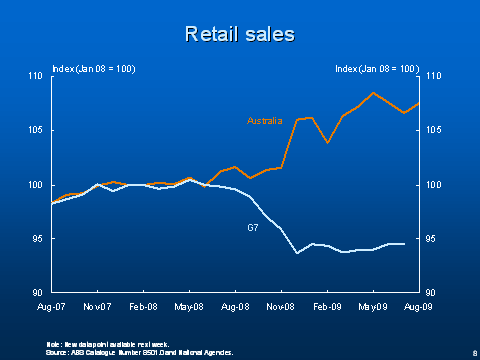
Similarly, stronger cash flows, a generally brighter outlook and our tax breaks have helped us to avoid the crippling falls in business investment seen in some of the major advanced economies.
Chart Eight: Business investment growth
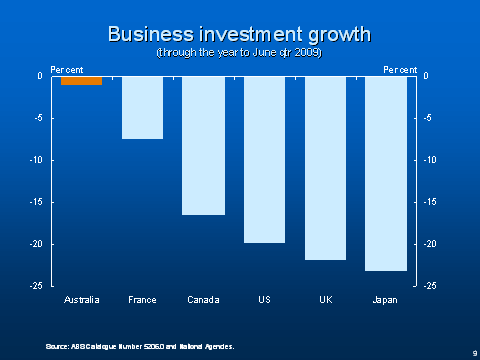
Continued Support for Manufacturing and SMES
Given the audience today, I also want to make some remarks about the manufacturing sector and small and medium businesses, in particular.
Manufacturing
Australia's manufacturing sector employs over a million people, or 10 per cent of all people employed in Australia.
The manufacturing industry has been hit hard by the global financial crisis, but thankfully is beginning to recover. Manufacturing employment has fallen by 29,100 over the 12 months to August 2009, having recovered some lost ground in the most recent quarter.
Your own Performance of Manufacturing Index (PMI) now points to expanding activity, having recovered from very low readings in April 2009.
But the longer term challenges remain. The recent appreciation of the exchange rates presents new challenges for any manufacturing business engaged in export markets, or competing with imports domestically.
Unfortunately for many in this room, a stronger exchange rate may be with us for some time. We are now forecasting a stronger near term outlook for the terms of trade, with a longer adjustment period to return to long-term levels, suggesting there will be upward pressure on the exchange rate for some time. This means continued pressure on the manufacturing sector.
We recognise our nation needs a broad industrial base, that is competitive and vibrant. That's one reason why we are making the direct investments that are necessary to ensure the manufacturing sector is in the best possible position to meet the challenges of the future. Key measures include:
- $6.2 billion for the New Car Plan for a Greener Future automotive industry package – a Plan for reinventing the Australian car industry – preparing the industry for a low-carbon future and making it indispensable to global markets and supply chains;
- $2.4 billion innovation package, including $196 million to establish Commercialisation Australia; and
- $271 million for the Enterprise Connect network including $10 million for the Researchers in Business Scheme.
The Government has also established the Future Manufacturing Industry Innovation Council which will champion innovation in the manufacturing sector and help build connections between government and industry stakeholders.
The Commonwealth will spend around $8.6 billion on research and innovation this financial year – 25 per cent more than in 2008-09. An investment in our future that will help Australian businesses win the global contest for manufacturing sales.
SMEs
The global financial crisis has also hit small business hard.
Business surveys reported large and sustained falls in small business confidence and conditions throughout 2008 and early 2009. ACCI's Small Business Survey reported numerous indicators, including sales revenue, profit, employment and overtime utilisation, falling to their lowest levels on record.
Thankfully, we now appear to have turned the corner. ACCI's most recent Small Business Survey for the June quarter suggested that while still challenging, conditions for small businesses were recovering more quickly than other business and may help to lead the economic recovery. It would be interesting to test that proposition here today.
One concern I have is that this growth may be constrained by reduced access to credit. I know from talking to businesses right around the country that many are finding it tough to get bank credit and some feel they are paying excessive interest. And for many small business customers, I think the banks can do better.
To help address this, the Government outlined last month a proposal to invest up to a further $8 billion in residential mortgage backed securities. This is intended to assist smaller lenders to finance loans to small business borrowers and support competition in small business lending. It will help support competition in the small business lending market and put downward pressure on small business lending rates.
The Government is also committed more generally to providing better incentives for small businesses to innovate and drive efficiencies, so that they are well positioned to emerge stronger from the global recession.
One example is the new 45 per cent Refundable R&D Tax Credit for companies with an annual turnover of less than $20 million. The aim of the new Tax Credit is to provide more generous, more predictable, and less complex support to business – particularly small business.
Another example of our commitment to support small business is the provision of that $196 million I mentioned earlier, for the establishment of Commercialisation Australia. This initiative will give small and medium-sized companies the power to turn great ideas into commercial reality and support them in taking those ideas to market.
Longer Term Challenges
Now let's step back from all of these numbers and policy measures and adopt a longer-term perspective on some of the investments we need to make to secure our future.
Australia's medium- to long-term economic prospects are bright. Our fortunes remain inextricably linked to those of our Asian neighbours. We stand to benefit greatly from the resumption of the commodities boom. But it must be managed well.
We enjoy vast mineral wealth that we can transform into permanent benefits for all Australians, now and into the future. Strong, sustained demand for our resources will present immense opportunities and challenges. But we can't fall back into the trap of the previous government, of relying on a commodities boom to support our living standards for ever.
We need policies that enhance our productivity and competitiveness and that expand the economy's long-run capacity. By this I mean policies such as our nation building agenda, our Education Revolution, and ongoing microeconomic reform.
On population and demographic challenges, the third Intergenerational Report is due to be released before the 2010-11 Budget. The last report was released in 2007, and a lot has certainly changed since then. I've indicated that we see population challenges as one of the top issues on the agenda.
And on taxation, I would like to acknowledge the important contribution that Heather is making. We are pursuing a once in a generation opportunity to achieve comprehensive reform of our taxation system to make it fairer, simpler and more competitive.
We expect that the Panel's report will provide us with a sturdy framework for reform that will help us make important decisions into the future. And there will be some difficult policy choices to make.
I'm afraid I won't have much more to say this morning on tax, however. I am due to speak in more detail on that later today and would prefer to keep my powder dry.
And of course, this Government remains committed to tackling climate change and gaining passage of CPRS legislation this year. Passage of CPRS legislation will help provide certainty to industry and will provide the necessary policy framework to put us on a sustainable low-carbon growth path over the coming decades.
Conclusion
I thank you again for what you've done to help make Australia the best-performing of the advanced economies. What you've done to hold on to most of your workers. And what you've done to ensure we are well-positioned for recovery.
It's the sort of commitment and leadership you have exhibited in recent months that we're going to need if we're to meet the big challenges on our horizon.
I look forward to your questions, or even if you just want to express a view I'm all ears.
